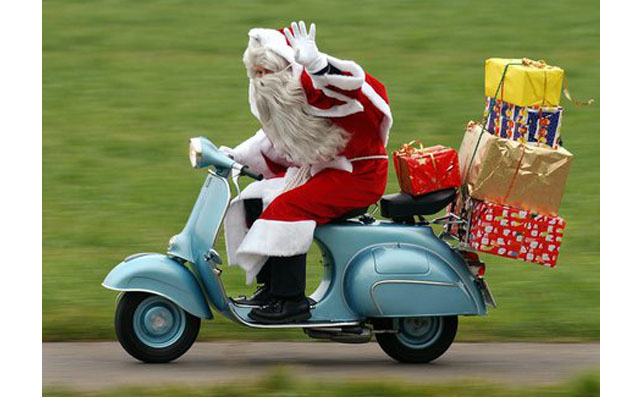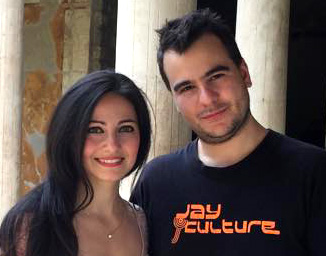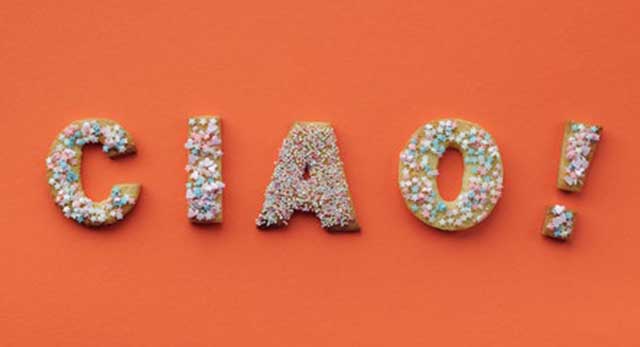
Guest Post di
Valeria Biancalani!
Oggi Valeria Biancalani ci spiega quali sono i modi formali e informali di salutare in italiano. Oltre a lavorare come insegnante di italiano da più di 10 anni, Valeria è la fondatrice di due scuole di lingue online: Parlando Italiano e BlaBlaLang, la prima scuola è incentrata esclusivamente sull’insegnamento dell’italiano; la seconda, invece, oltre alle lezioni di italiano online, offre lezioni di spagnolo e inglese. I corsi si basano sul metodo comunicativo per far sì che gli studenti imparino a usare la lingua in base alle varie situazioni comunicative e ai diversi obiettivi linguistici in modo facile e divertente.
Today Valeria Biancalani explains to us what are the formal and informal ways to greet one another in Italian. In addition to working as an Italian teacher for more than 10 years, Valeria is the founder of two online language schools: Parlando Italiano and BlaBlaLang, the first school focused exclusively on teaching Italian; the second, on the other hand, in addition to online Italian lessons, offers Spanish and English lessons. The courses are based on the communicative method to ensure that students learn to use the language according to various communication situations and different language goals in an easy and fun way.
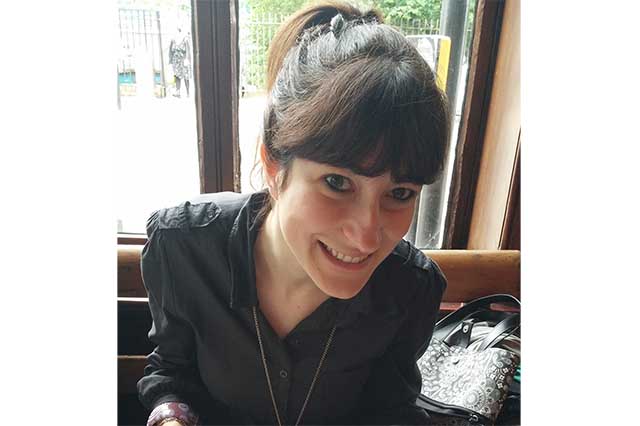
Se c’è una cosa che si può affermare della lingua italiana è che questa è ricca di sfaccettature. Ogni parola può avere più significati e anche un’azione semplice, come il salutare qualcuno, ha più espressioni.
If there is one thing that can be said about the Italian language, it is that it is full of nuances. Each word can have multiple meanings and even for a simple greeting, there can be a variety of ways of expressing “hello” and “goodby.”
In questo articolo vi andremo a far conoscere tutti i modi per salutare qualcuno in italiano in modo formale e informale.
In this article, we are going to introduce you to all the ways to greet someone in Italian in a formal and informal way.

I saluti informali in Italiano
Informal Greetings in Italian
I saluti informali sono quelli usati con gli amici o con con le persone con cui si ha un certo grado di confidenza. Cominciamo con quelli che si usano quando ci si incontra.
Informal greetings are those used with friends or with people with whom you have a certain degree of confidence. Let’s start with the ones you use when you meet someone.
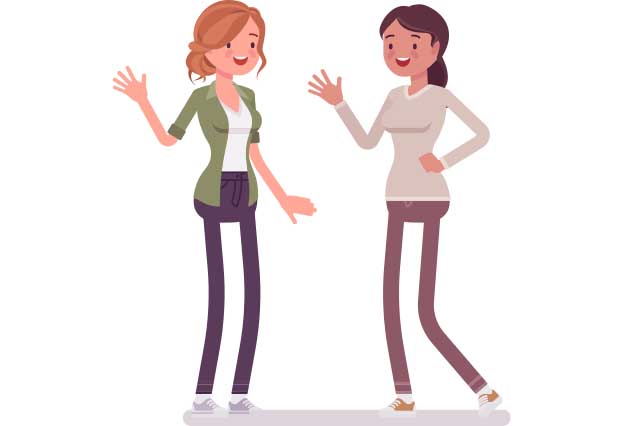
CIAO
CIAO e probabilmente il più famoso dei saluti, viene usato sia quando si arriva sia quando si va via.
“Ciao!” is probably the most famous of greetings. It is used both when arriving and when leaving.
Ciao! Come stai?
Hello! How are you?
Ciao, ci vediamo domani allora
Hi, see you tomorrow then.
Hey!
HEY è il saluto informale che va usato soltanto con amici e parenti. È assolutamente da evitare con chi non si conosce o con persone con le quali si intrattengono, per esempio, rapporti di lavoro.
HEY is an informal greeting that should only be used with friends and relatives. It is absolutely to be avoided with those you do not know or with people with whom you have, for example, working relationships.
Hey! Da quanto tempo non ci vediamo.
Come stai?
Hello! How are you?
Ciao, ci vediamo domani allora
Hey! It’s been a while since we’ve seen each other.
How are you?
Eihlà!
EHILÀ. Molto simile ad hey, è un saluto informale che va usato, anche questo, solo con amici o persone con le quali si ha confidenza.
HEY THERE Is much like hey. It is an informal greeting that should also be used only with friends or people with whom you are familiar.
Ehilà! Tutto bene? Come sta la famiglia?
Hey there! Everything okay? How’s the family doing?
Buongiorno
BUONGIORNO. Il buongiorno viene identificato principalmente come saluto formale ma può essere inserito anche nel gruppo di quelli informali, soprattutto se detto con un tono allegro e scherzoso. In italiano, come in qualsiasi lingua, anche la cadenza vocale può fare la differenza!
Good Morning is mainly identified as a formal greeting but can also be inserted in the group of informal ones, especially if said with a cheerful and playful tone. In Italian, as in any language, even the vocal cadence can make a difference!
Buongiorno mamma! Cosa c’è per colazione?
Good morning mom! What’s for breakfast?
Buondì
BUONDÌ. È l’equivalente informale del buongiorno.
Buondì is mainly identified as a formal greeting but can also be inserted in the group of informal ones, especially if said with a cheerful and playful tone. In Italian, as in any language, even the vocal cadence can make a difference!
Buondì a tutti!
Good morning everyone!
Vediamo adesso i saluti informali di congedo.
Now let’s look at the informal farewell greetings.
Ci vediamo
CI VEDIAMO. Anche questo saluto viene usato principalmente con gli amici ed implica una conoscenza reciproca approfondita.
See you later. This greeting is also used mainly with friends and implies familiarity with one another.
Ci vediamo la prossima settimana!
We’ll see each other next week!
Ci sentiamo
CI SENTIAMO. Usato soprattutto con amici e parenti. Non necessariamente sta a significare che ci si sentirà davvero con l’altra persona, è più un modo di dire.
We will talk soon. This phrase once again is used mainly with friends and family. Sentire in Italian has several sensory meanings, i.e., smell, hear, touch, taste. In this instance, “sentire” does not necessarily mean that you will actually “feel” the other person. It is an idiom that means will talk soon.
È stato bello vederti. Ci sentiamo!
It was nice to see you. We will talk soon!
Alla prossima
ALLA PROSSIMA. Questo saluto sta a significare che ci si rivedrà seppur non sapendo precisamente quando.
Until next time. This greeting means that we will meet again even if we don’t know exactly when.
Allora, alla prossima!
So, see you next time!
Buonanotte
BUONANOTTE. Questo saluto si usa alla fine della giornata, prima di andare a dormire.
Goodnight. This greeting is used at the end of the day, right before going to sleep.
Buonanotte papà. Sogni d’oro!
Goodnight dad. Sweet dreams!
I saluti formali in italiano
Formal greetings in Italian
I saluti formali sono quelli usati con chi si ha poca confidenza e con coloro con i quali si intrattengono rapporti strettamente professionali. Cominciamo, anche qui, con i saluti di apertura.
The formal greetings are those used with those who you don’t know well and with those with whom we’d like to maintain a strictly professional relationship. Let’s begin with greetings.
Salve
SALVE. Così come “ciao”, anche “salve” può essere usato sia come formula di presentazione sia per congedarsi. Inoltre “salve” è il tipico saluto che viene usato quando si è incerti sul grado di formalità della conversazione.
Salve also like “ciao” can be used in a formal manner to say goodbye. Furthermore, “salve” is the typical greeting used when unsure of the degree of formality of the conversation.
Salve, mi chiamo Andrea Rossi.
Hi, my name is Andrea Rossi.
Buongiorno
BUONGIORNO. Si usa la mattina, generalmente fino all’ora di pranzo.
Good morning is used in the morning, generally until lunchtime.Buongiorno, vorrei parlare con il dottor Bianchi per favore.
Buongiorno, vorrei parlare con
il dottor Bianchi per favore
Hello, I would like to speak to Dr. Bianchi please.
Buonasera
BUONASERA. Si usa principalmente dal tardo pomeriggio in poi.
Good evening is mainly used from 2:00 in the afternoon onwards.
Buonasera, un tavolo per due grazie.
Good evening, a table for two, thank you.
Vediamo adesso, i saluti formali di congedo.
Now let’s look at formal farewell greetings.
Buona Giornata &
Buona Serata
BUONA GIORNATA & BUONA SERATA. Si usano formalmente per salutare qualcuno alla fine di una conversazione.
Good day & Good Evening These two greetings are used formally to address a farewell to someone at the end of a conversation.
Grazie per la deliziosa cena. Buona serata!
Thanks for the delicious dinner. Have a good evening!
Buona giornata, avvocato.
Have a good day, sir.
(Note: In Italian, one would use the professional title of the person such as “lawyer”. But in English we would drop the title and politely say “sir,” or leave it off entirely).
È stato un piacere.
È STATO UN PIACERE. Saluto formale che indica simpatia nell’aver fatto una conoscenza.
It was a pleasure is a formal greeting that indicates the pleasure of having made an acquaintance.
Grazie per la deliziosa cena. Buona serata!
Thanks for the delicious dinner. Have a good evening!
Arriverderci &
Arrivederla
ARRIVEDERCI/ARRIVEDERLA. Saluto di commiato classico. La prima formula può essere usata verso un gruppo di persone, la seconda verso una sola persona.
Goodbye is a classic farewell greeting. The first formula can be used for a group of people, the second for a single person.
Grazie e arrivederci!
Thank you and goodbye!
Arrivederla signora.
Looking forward to seeing you again, madam.
Addio
ADDIO. È una forma di commiato definitiva e si usa davvero molto raramente. Implica il non rivedersi più.
Goodbye is an ultimate form of farewell and is very rarely used. It implies never seeing each other again.
Addio per sempre.
Goodbye forever.
Curiosità: La gestualità
nella lingua Italiana
Fun facts: Gesturing in the Italian Language
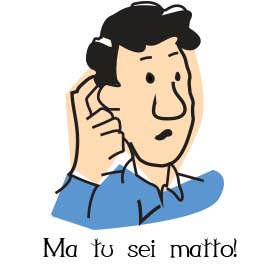
Gli italiani sono famosi in tutto il mondo per il loro modo di gesticolare. Anche nei saluti vi sono dei gesti fisici ricorrenti. Vediamo quali sono.
Italians are famous all over the world for their hand gestures. Even in their greetings, there are recurring physical gestures. Let’s see what they are.
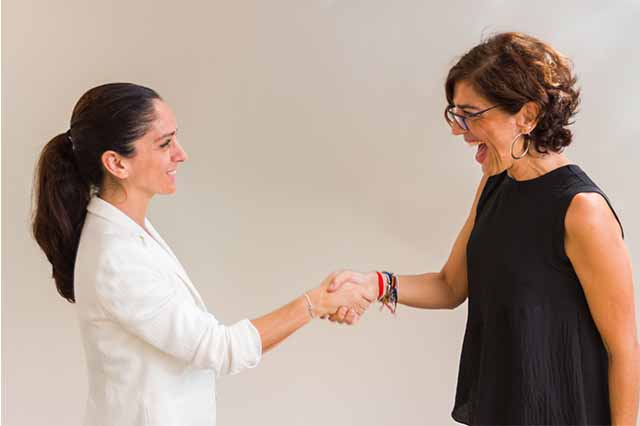
STRETTA DI MANO. È il saluto formale per eccellenza e viene usato in due occasioni: quando ci si presenta per la prima volta a qualcuno che non si conosce, o quando si saluta una persona che si conosce, ma con la quale si intrattiene un rapporto distaccato e convenzionale, per esempio una persona con la quale si lavora.
Handshake. A handshake is the formal greeting par excellence and is used on two occasions: when you first introduce yourself to someone you don’t know, or when you greet a person you know, but with whom you have a detached and conventional relationship, for example, a person you work with.
BACI SULLE GUANCE. I baci sulle guance sono un tipico saluto italiano e si usano quando si è in stretta confidenza con l’altra persona. Si usano con amici e parenti.
Kisses on the cheeks. Kisses on the cheeks are a typical Italian greeting and are used when you are in close confidence with the other person. They are used with friends and relatives.
ABBRACCIO. Proprio come per i baci, l’abbraccio viene usato con chi si conosce molto bene. È un saluto particolarmente affettuoso che va a simboleggiare una vera e propria contentezza nel vedere l’altra persona.
Hugs. Just like for kisses, the hug is used with those who know each other very well. It is a particularly affectionate greeting that symbolizes real contentment in seeing the other person.
IL CINQUE. Battere il cinque è un saluto prettamente giovanile e lo usano soprattutto gli adolescenti.
The High Five is a purely youthful greeting and is mostly used by teenagers.
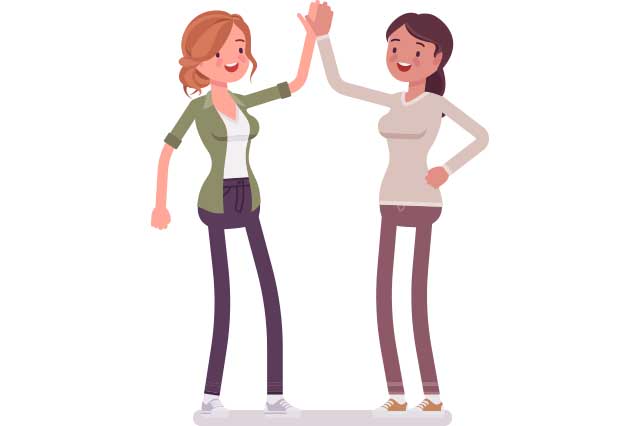
Grazie Valeria! Dammi cinque!
Thanks Valeria! Give me five!
Che spiegazione fantastica su come dire “CIAO” e “Arrivederci” in italiano. È stato un vero piacere averti qui tra noi sul blog Studentessa Matta! I tuoi commenti sono ben apprezzati. Torna a trovarci presto!
What a great and thorough explanation of how to say hello and goodbye in Italian. It was a real pleasure to have you here with us on the Studentessa Matta blog! Your comments are well appreciated. Come back and see us again soon!
Potete trovare Valeria Biancalani sui suoi siti Parlando Italiano e BlaBlaLang dove insegna italiano online, spagnolo e inglese.
You can find Valeria Biancalani on her sites Parlando Italiano e BlaBlaLang where she teaches Italian online, as well as Spanish and English.

